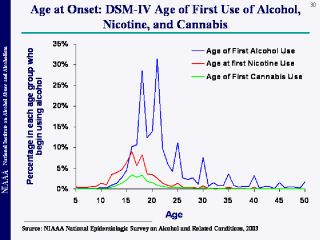Search for most updated materials ↑
| front |1 |2 |3 |4 |5 |6 |7 |8 |9 |10 |11 |12 |13 |14 |15 |16 |17 |18 |19 |20 |21 |22 |23 |24 |25 |26 |27 |28 |29 |30 |31 |32 |33 |34 |35 |36 |37 |38 |39 |40 |41 |42 |review |
 |
Adolescents are the healthiest cohort
in the population in terms of organic disease but, at the same time,
they experience relatively high rates of mortality and morbidity due
to their behavior, including the use of alcohol. Across many
species including humans, adolescence is a time of heightened
risk-taking and for many young people in our society, some of that
risk-taking involves alcohol use. Further, adolescence is a period
of increasing socialization often involving alcohol. For some, the
increased social demands of adolescence may be accompanied by
increased anxiety heightening the risk for alcohol use. In this
way, alcohol use has become intertwined with the normal
developmental processes of adolescence. And alcohol use both
affects development and is affected by developmental processes.
|